Last Updated on January 19, 2024 by Greg Gillson
You might not expect it, but winter bird feeding in Georgia is fantastic! If you’ve never set up a bird feeder before, or are just looking for new ideas, then this article is for you!
This article discusses why and how to feed winter birds in the state of Georgia. It discusses setting up a bird feeding station. It also shows you photos and gives identification tips for the common birds you can attract to your feeder in winter.
Winters in Georgia can be cool in the south and cold in the northern mountains. Some freezing weather in winter is typical inland in winter. The 10-year average temperature for 2010-2019 in Atlanta in January was a high of 53° F and a low of 35° F. This means that you will have some hungry birds visiting your feeders!
Why feed winter birds in Georgia?
Georgia has many birds that spend the entire year and love to eat at bird feeders. Georgia is also visited in winter by birds from the north, escaping the harsh weather. Many of these, too, will also visit your feeders. The result is that you will have many different types of birds at your feeder.
No, these birds probably don’t need your winter bird feeders to survive the winter. The weather isn’t that harsh, and natural foods are abundant. Still, setting up a bird feeder and making your yard attractive to birds can benefit birds.
You can make your backyard a safe haven for the local birds. Food, water, and some thoughtful landscaping can make your yard attractive to birds. You can mitigate some of the effects of continuous urban sprawl.
Often it is young birds, experiencing their first winter, that benefit the most from backyard feeders. These birds are not yet experienced in finding food in winter. Your bird feeders are a welcome bonus to them.
Of course, you may benefit more than the birds. Watching birds at the feeder relieves stress and gives many hours of enjoyment. They brighten up a dreary winter day. Feeding and watching birds gives us a connection to the natural world that many people are missing in their daily lives.
You may also find that feeding birds gives you a connection with other people who feed birds. Your feeders are obvious. Neighbors will notice. You may find you share the joy of feeding birds in common. You’ll meet others with the same interest at the bird feeding department or nature store.
What birds come to feeders in Georgia in winter?
Georgia has a long list of common winter feeder birds! I’ll show you the most expected below.
But Georgia also has many backyard birds that don’t necessarily come to feeders. They visit your backyard for the protection of trees or bushes you may have. They may be more interested in insects or invertebrates in your yard or shrubs. Or they may come only for the water in your bird baths.
These common backyard birds are in my related article: common backyard birds of Georgia. I’ll link to this again at the end of this article.
Here, then are some of the birds you can attract to your feeder in Georgia. How many visit your feeders?
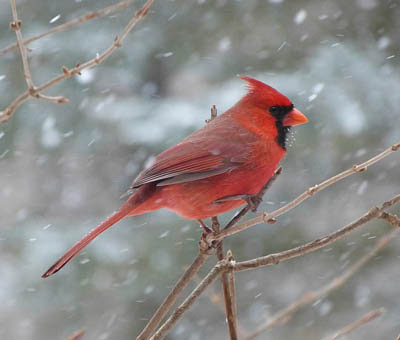 |
| Northern Cardinal Image by tlparadis from Pixabay |
Northern Cardinal:
These birds that are a favorite in the East may be the most common bird at your feeder in Georgia!
They are found in deciduous woods in the eastern, central, and southern United States and eastern Mexico. In Georgia they are year-round residents.
They are medium birds with full long tail. The big head has a thick bill and a fancy crest. Males are bright red, females tan, with a black face.
They sing throughout the year, a loud liquid whistle such as birdy birdy birdy.
Northern Cardinals eat larger seeds include sunflower and safflower seeds. They prefer a platform feeder.
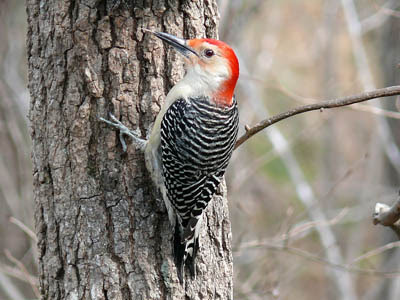 |
| Red-bellied Woodpecker Image by skeeze from Pixabay |
Red-bellied Woodpecker:
These medium-sized woodpeckers are fairly easy to attract to your backyard feeders.
These birds are found in woodlands in the eastern, central, and southeastern parts of the United States. They are year-round residents in Georgia.
The bodies are stocky. The head is large with a big chisel-shaped bill. The tail is short, stiff, and pointed. The body is pale gray. The back and wings are striped with fine black-and-white lines. The back of the head is red, covering the crown on males.
Their common call is a rolling churr.
Red-bellied Woodpeckers eat peanuts and tree nuts from platform feeders. They love suet offered in suet feeders.
 |
| Carolina Chickadee Image by GeorgeB2 from Pixabay |
Carolina Chickadee:
These friendly birds will enliven your backyard feeders.
They are common in deciduous woodlands and backyards in the southeastern United States. They are residents throughout the year in Georgia.
Chickadees have plump little bodies and a large head. The bill is small and stout. The tail is fairly long and round-ended. They are gray above and paler below. They have a black cap and bib contrasting with a white face.
Their calls include a husky chick-a-dee-dee-dee. They have a whistled fee-bee fee-bay song.
Carolina Chickadees like black oil sunflower seeds and eat from tube or hopper feeders.
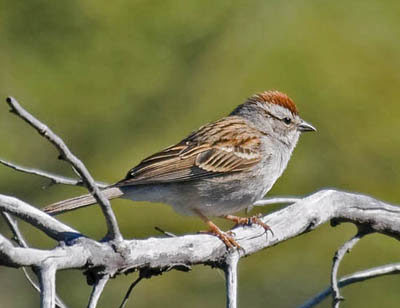 |
| Chipping Sparrow Photo by Greg Gillson |
Chipping Sparrow:
Look closely at your winter sparrows and you may spot these.
These birds breed in orchards or scattered patches of fields and woodlands throughout Canada and most of the United States and highlands of Mexico. They winter widely across the southern United States and Mexico. Georgia is right on the edge of the breeding and wintering area. They are resident throughout most of Georgia, but only breed in summer in the far north and are found only in winter in the far south parts of the state.
These sparrows are small and slim with a longer thin forked tail. They are gray underneath, the back and wings are brown with darker streaks. The face is rather plain with a thin black line behind the eye. The chestnut crown in summer is paler and streaked with fine brown lines in winter.
In winter they give a high-pitched and rather hard seeep call.
Chipping Sparrows eat small seeds such as those found in the mixed seed blends. They eat best from the ground or on a low platform feeder, but will use a hopper feeder, too.
 |
| Blue Jay Image by skeeze from Pixabay |
Blue Jay:
These are well-known backyard birds in the East.
They are found in woodlands east of the Rocky Mountains from Canada south to Florida and Texas. Birds in much of Canada move south in winter. They are found year-round in Georgia.
These birds are stock with a large rounded tail. The crest is fairly obvious on the large had with strong bill. They are blue above and white or gray below. The wings and tail have black and white bars on blue. A black necklaces wraps up behind the head.
Common calls include a raspy jay jay jay.
Blue Jays love peanuts but also may grab up mouthfuls of sunflower seeds and go off and bury them to eat later in winter (food caching). To keep them from running away with all the sunflower seeds feed sunflower seeds from tube feeders where they can only get one at a time.
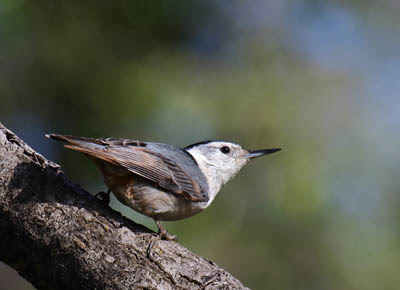 |
| White-breasted Nuthatch Photo by Greg Gillson |
White-breasted Nuthatch:
These birds will be regular visitors at your feeder.
In he East they are mostly found in deciduous trees. In the West they are found primarily in oaks and pines. They are resident across most of Canada and the United States and the mountains of Mexico. They are resident throughout most of Georgia, but absent in the south or southeastern part of the state.
They are small and stock with a big head on a short neck. The tail is stubby. The bill is long and sharply pointed. Above they are blue-gray. Below they are white including most of the head and face, except for a thin strip of black over the crown.
Calls vary regionally, but include yank yank calls in Georgia.
White-breasted Nuthatches eat black oil sunflower seeds that they take from tube or hopper feeders one at a time. They fly away to a tree to pound the seeds open. After eating one seed, they fly back to the feeder for another.
 |
| House Finch Photo by Greg Gillson |
House Finch:
These birds are especially common at feeders in residential areas.
They are residents cross most of the United States and extreme southern Canada, as well as into Mexico. They are year-round residents in Georgia.
They are small and rather slim birds with longer tail and big head. The thick seed eating bill is obvious. Birds of both genders are dusty gray and darker brown, with heavy streaked lines on the sides and flanks. Males have reddish-orange forehead, upper breast and throat, and rump.
The common calls include rising chirping calls and a lively warbled song.
House Finches love black oil sunflower seeds from tube or hopper feeders. They also eat Niger seed from thistle feeders.
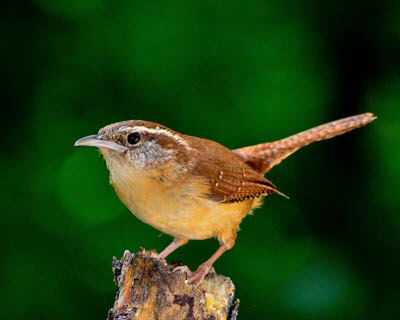 |
| Carolina Wren Image by the SOARnet from Pixabay |
Carolina Wren:
By offering a variety of foods you can attract birds that don’t eat seeds, like this wren!
These small birds of brushy tangles are found in the eastern and southeastern United States. They are year-round residents in Georgia.
They are plump birds with big heads and a long floppy tail. The bill is long, sharp pointed, and curves down slightly. They are rich brown above and softly buff below. They have a long white eyebrow stripe.
They are year-round songsters that whistle lively cheery cheery cheery songs or tea-kettle tea-kettle tea-kettle.
Carolina Wrens eat grubs and insects. But they will come to feeders to eat mealworms and suet.
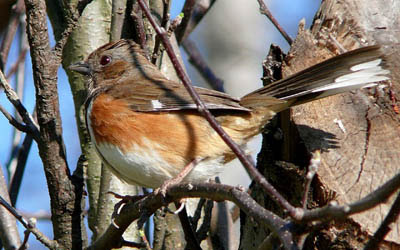 |
| Eastern Towhee Image by skeeze from Piabay |
Eastern Towhee:
These birds are shy. Look for them under bushes at the edge of your yard.
They live in brushy tangles and understory plants in the eastern United States. Northern birds migrate south in winter. In Georgia these birds are year-round residents.
These are large sparrows with large full rounded tail and big head with thick seed-eating bill. Males are blackish above, including a hood over the head. The wings and tail have large white spots. the sides are bright rusty and the lower belly is white. The iris is red in most areas, white in Florida. Eye color is variable in southern Georgia.
They call a rising chweee. The song has one or two metallic opening notes and a long sweet trill: drink teeeeea or drink your teeeeea.
Eastern Towhees feed on the ground and will eat mixed seeds and sunflower seeds from a platform feeder or hopper feeder.
 |
| Tufted Titmouse Image by Anne773 from Pixabay |
Tufted Titmouse:
These small birds are common at feeders in the East.
These birds are found in deciduous woods and residential areas in the eastern United States. They are year-round residents in Georgia.
They are small and stocky or plump with a large head with wispy crest. The small bill is rather stout. The tail is fairly long. They are blue-gray above and paler below. The black eye stands out on the pale face because there are additional black feathers around the eye. They also have a black forehead which causes the bill to look larger than it really is.
They sing throughout the year a whistled Peter Peter Peter.
Tufted Titmouses eat black oil sunflower seeds at tube and hopper feeders.
 |
| White-throated Sparrow Photo by Greg Gillson |
White-throated Sparrow:
These birds are common at feeders in winter east of the Rocky Mountains.
They breed in woodlands and brush across Canada and into the northeastern United States. In the winter they are primarily found in the eastern and southeastern United States. They winter throughout Georgia.
These are fairly large sparrows with long tails. In general they appear as rather long throughout, and not as plump as some sparrows appear. They have dark brown stripes on the creamy brown back. The wings are dark brown, as is the tail. The underparts are gray, contrasting sharply with a white throat. The head is striped with black and white or black and tan lines. The feathers above the eye line, between the eye and bill, are yellow.
They give a loud metallic pink call. In spring they sing Oh sweet Canada Canada Canada.
White-throated Sparrows like mixed seeds on platform feeders or on the ground.
 |
| Mourning Dove Photo by Greg Gillson |
Mourning Dove:
These birds are common at feeders across the United States.
They are resident in most regions in both open country and residential habitats. Summer birds in Canada and the north Plains states migrate southward in winter. These doves are resident throughout Georgia.
They are plump with a small round head and long pointed tail. The back and wings are brownish and the underparts are paler pink. They show black spots on the wings and a dark mark on the side of the neck.
Their call is a mournful boo-hoo hoo hoo hoo.
Mourning Doves like all kinds of seeds, grains and corn, and nuts. They eat from the ground and on platform feeders, but even squeeze onto small hopper feeders.
 |
| Brown-headed Nuthatch Image by mlmclaren from Pixabay |
Brown-headed Nuthatch:
These are very local and generally rare in the Southeast U.S.
Flocks of these birds live in pine forests. They are found throughout most of Georgia except for the far northeastern corner.
These are tiny stocky birds with a big head and stubby tail. The bill is rather short and pointed. They have short legs with larger strong feet. The flight feathers are dark, the back blue-gray. The crown and hind neck is brown. The lower face is white. The under parts are buff.
Calls include squeaky double notes and twittering.
Brown-headed Nuthatches love black oil sunflower seeds and nuts from tube and hopper feeders. They also eat suet.
 |
| Song Sparrow Photo by Greg Gillson |
Song Sparrow:
These are common birds in most of North America.
These birds are found in brushy open areas and wetlands, but also in residential areas.
They breed from coastal Alaska across Canada, in the West and Northeast across the mid-latitudes of the United States. In winter they migrate southward out of interior Canada, the northern Great Plains and much of the Midwest–all areas where water is frozen most of the winter. These birds are found year-round only in northern Georgia, but in winter throughout the state.
They are plump birds with a rounded tail and a good-sized head with thick bill for eating seeds. They are bray and brown with darker brown stripes on the back. The white under parts have lots of brown streaks on the sides and especially in the center of the upper breast where a spot of these streaks converge. The face is striped with dark streaks on the lateral crown, behind the eye, on the lower edge of the ear covert, and on the side of the throat.
They give a chimp call and sing most of the year, 3 husky notes, then a loose trill or tumble of notes: Madge Madge MADGE! Put on your tea-kettle, please.
Song Sparrows like smaller seeds on the ground, platform, or hopper feeder.
 |
| Downy Woodpecker Photo by Greg Gillson |
Downy Woodpecker:
These small woodpeckers are common at feeders.
They are found in deciduous woods and wooded stream sides from Alaska and across Canada southward across the entire United States except for the western and southwestern deserts. In Georgia these birds are resident all year long.
Their bodies are rather heavy and stocky. The have a short tail with pointed feathers they use to prop themselves against a tree trunk. The head is fairly large, but the bill is small for a woodpecker, though it still shows the straight chisel-shape of the clan.
Their call is a sharp pik!
Downy Woodpeckers love suet at your feeder.
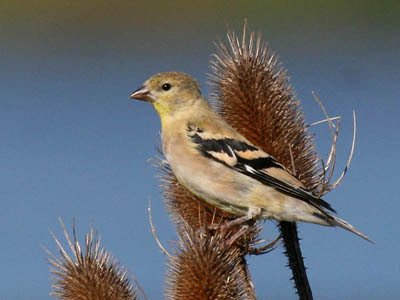 |
| American Goldfinch Photo by Greg Gillson |
American Goldfinch:
These are fairly common birds at feeders in winter.
They are grassland and open country birds that require some scattered trees.
In summer they breed across southern Canada and the northern 2/3rds of the United States. In winter they pretty much leave Canada and are found throughout the US. They are year-round residents in northern Georgia, only winter visitors in the southern part of the state.
They are small and slim with a short forked tail and long wings. They have a small conical bill suitable for eating small seeds. The bright yellow summer males with the black crowns are much more subdues in winter, appearing much as the same as the pale brown females. Both share the black wings and tail with large white bars and patches.
In flight they give a per-chick-o-ree call.
American Goldfinches eat sunflower seed hearts from hopper feeders, small black oil sunflower seeds from tube feeders, and Niger seeds from thistle socks and feeders.
Setting up a winter bird feeding station in Georgia
Wow, there are so many common winter feeder birds in Georgia that it is hard to narrow down a simple feeding station. I want to recommend everything!
A tube feeder filled with black oil sunflower seeds will attract the Carolina Chickadee, Brown-headed Nuthatch, House Finch, White-breasted Nuthatch, American Goldfinch, and Tufted Titmouse. These birds will also eat the sunflower seeds from other types of feeders. But the tube feeder is more about keeping out the larger bully birds and allowing these smaller birds to eat in peace.
Put out a hopper feeder with a good mixed bird seed blend that includes a good amount of sunflower seeds and white proso millet (and very little other filler seed such as milo, wheat, or cracked corn). This will attract most of the ground feeding sparrows and other birds: Northern Cardinal, Eastern Towhee, Song Sparrow, Mourning Dove, White-throated Sparrow, and Chipping Sparrow.
Then, I’d be sure to put out suet in a suet cage or upside-down feeder. Birds attracted to this will include the Downy Woodpecker and Red-bellied Woodpecker. But also, the Carolina Wren, and Tufted Titmouse, and White-breasted Nuthatch, and many other birds not listed above may be attracted to the suet.
And don’t forget to add water to your bird feeding station. A bird bath is always welcome by birds–even birds that don’t normally eat at a bird feeder.
Wrapping Up
Whether you need to fill your backyard bird feeder in winter in Georgia depends on a few factors:
Factors to consider:
- Bird species you want to attract: Some birds, like resident chickadees and cardinals, readily visit feeders year-round in Georgia’s milder winters. But migratory species like warblers and thrushes might not be present, reducing the need for constant feeding.
- Local food availability: If your area offers ample natural food sources like berries, seeds, and insects, birds might not rely heavily on feeders. However, colder periods might reduce natural food, making feeders more attractive.
- Your feeding preferences: Choose to fill your feeder regularly if you enjoy observing birds and providing supplemental support, especially during harsh weather.
My overall advice is to stay engaged with your feeder, monitor it and the birds that visit. Getting to know what is happening in your backyard will help you get the most out of it.
Frequently Asked Questions
What birds stay in Georgia in winter?
Many fascinating birds grace Georgia’s landscapes even during the winter months! While some species migrate south for warmer climates, a diverse number of visitors make the state their winter home. Here are some common birds you might encounter:
- Dark-eyed Junco: These gray birds with white wing bars hop along the ground searching for seeds and berries, often seen in flocks along roadsides and open fields.
- Common Redpoll: These small, finch-like birds with red caps migrate south from Canada and can be seen in open fields and woodlands, feeding on seeds and berries.
- Pine Siskin: These irruptive migrants with yellow streaks and wing bars appear in Georgia winters in response to abundant conifer seed crops.
- White-throated Sparrow: These handsome sparrows with bold black and white markings readily visit feeders for seeds and can be heard singing their “Old Peabody, Peabody, Peabody” song.
- Evening Grosbeaks: These striking yellow and black birds with large beaks migrate south from Canada and can be seen at feeders, especially for sunflower seeds.
Do bluebirds winter in Georgia?
Yes, some bluebird species do winter in Georgia! The Eastern Bluebird is the most common bluebird you’ll see in the state, and its migration patterns are quite interesting:
Eastern Bluebird Migration:
- Northern populations: birds from further north, like Canada and the northern US, migrate south for the winter, reaching states like Georgia, Alabama, and Florida.
- Southern populations: blue birds breeding in southern states like Georgia and the Carolinas may stay year-round or only move short distances, intermingling with migratory birds in the winter.
Therefore, you’re quite likely to see blue birds in Georgia during the winter months. In fact, their population might even swell due to migratory birds joining the resident ones. Look for them in open areas like fields, meadows, and orchards, where they readily perch on fences and trees, hunting for insects.
Related Articles:
The most common backyard birds in Georgia
My recommended bird feeder setup











Thanks so much for sharing these photos and the info on each bird.
You are welcome, AHG. Thanks for stopping by and sharing.